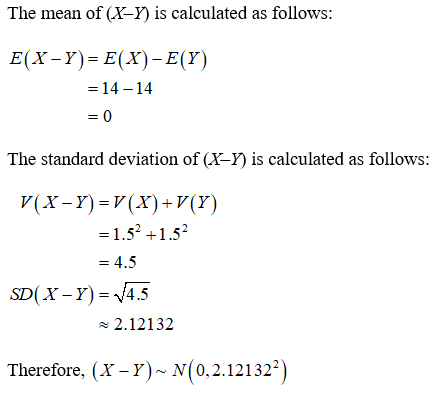
Concept explainers
Ava's morning routine is
Find the probability that the first morning selected is more than 2 minutes greater than the second morning time?
Interpret this probability.
Let X and Y are the first and second mornings.
It is given that X and Y are independent and identically distributed (i.i.d) as normal with mean of 14 minutes and a standard deviation of 1.5.
It is known that the difference of two independent normal random variables is also a normal random variable.
That is, (X–Y) is also a normal random variable.

Step by stepSolved in 3 steps with 2 images

- QUESTION 8 According to BusinessWeek, 44% of advertisers claim they have been a victim of internet click fraud. If 120 advertisers are survey more of them will claim they have been a victim of internet click fraud, a. None of the answers is correct Ob.0.8310 OC. 0.6293 d. 0.3707 e.0.1690 QUESTION 9 Assume the cost for an automobile repair is normally distributed with a mean of $524 and a standard deviation of $149. If the cost lower 7% of automobile repair charges, what is your cost? Click Save and Submit to save and submit. Click Save All Answers to save all answers. MacBook Air 20 F3 D00 F4 F2 F5 $ & 1 4 Q W R T Y #arrow_forwardSolve the problem.Assume that mountain lions' weights are normally distributed with a mean of 62.6 kilograms and a standard deviation of 2.6 kilograms. If 70 mountain lions are randomly selected, find the probability that they have a mean weight between 61.9 kilograms and 62.8 pounds.arrow_forwardThe Powerball lottery jackpot has a winning probability of 1/189,000,000. If you only consider the options of winning the jackpot ($100,000,000) or losing, what the is the mean value of a ticket that costs $2 to buy? At what point does the mean value of a ticket become positive?arrow_forward
- A professor knows that her statistics students' final exam scores have a mean of 79 and a standard deviation of 12.4. In his class, an "A" is any exam score of 90 or higher. This quarter she has 25 students in her class. What is the probability that 7 students or more will score an "A" on the final exam?arrow_forwardYou play a game of chance that you can either win or lose (there are no other possibilities) until you lose. Your probability of losing is p = 0.61. What is the probability that ita. takes 2 games until you lose. b. takes 5 games until you lose. c. Find the mean c. Find the standard deviation.arrow_forwardTrucks in a delivery fleet travel a mean of 100 miles per day with a standard deviation of 38 miles per day. The mileage per day is distributed normally. Find the probability that a truck drives at least 141 miles in a day. Round your answer to four decimal places.arrow_forward
- Please explain. Thanks.arrow_forwardAccording to a study done by De Anza students, the height for Asian adult males is normally distributed with an average of 66 inches and a standard deviation of 2.5 inches. Suppose one Asian adult male is randomly chosen. Let X = height of the individual. Find the probability that the person is between 64 and 69 inches. The middle 40% of heights fall between what two values?Write the probability statement. State the two values. (Round your answers to one decimal place.) x1,x2 ch6#9arrow_forwardCitizens use an average of 650 pounds of paper a year. Suppose that the distribution is normal with a population standard deviation of 153.5 pounds. Suppose you take a random sample of 25 Citizens. What is the probability that the mean pounds of paper used in a year are between 500 and 700 poundsarrow_forward
- A fair coin is flipped 100 times . Find the mean and standard deviation for the number of tails for this distribution.arrow_forwardJA researcher takes an SRS of 80 people who go golfing.The average to be u52 years old. It was also determined that the standard deviation of cac ot golfers was la What is the probability that the sample mean is kss. than 47 years old? age of all golferswas determined years.arrow_forwardCody took his first physics exam and scored an 80. The population mean for this exam is 70, and the standard deviation is 5. What is the probability of selecting a person with a score greater than Cody’s?arrow_forward
 MATLAB: An Introduction with ApplicationsStatisticsISBN:9781119256830Author:Amos GilatPublisher:John Wiley & Sons Inc
MATLAB: An Introduction with ApplicationsStatisticsISBN:9781119256830Author:Amos GilatPublisher:John Wiley & Sons Inc Probability and Statistics for Engineering and th...StatisticsISBN:9781305251809Author:Jay L. DevorePublisher:Cengage Learning
Probability and Statistics for Engineering and th...StatisticsISBN:9781305251809Author:Jay L. DevorePublisher:Cengage Learning Statistics for The Behavioral Sciences (MindTap C...StatisticsISBN:9781305504912Author:Frederick J Gravetter, Larry B. WallnauPublisher:Cengage Learning
Statistics for The Behavioral Sciences (MindTap C...StatisticsISBN:9781305504912Author:Frederick J Gravetter, Larry B. WallnauPublisher:Cengage Learning Elementary Statistics: Picturing the World (7th E...StatisticsISBN:9780134683416Author:Ron Larson, Betsy FarberPublisher:PEARSON
Elementary Statistics: Picturing the World (7th E...StatisticsISBN:9780134683416Author:Ron Larson, Betsy FarberPublisher:PEARSON The Basic Practice of StatisticsStatisticsISBN:9781319042578Author:David S. Moore, William I. Notz, Michael A. FlignerPublisher:W. H. Freeman
The Basic Practice of StatisticsStatisticsISBN:9781319042578Author:David S. Moore, William I. Notz, Michael A. FlignerPublisher:W. H. Freeman Introduction to the Practice of StatisticsStatisticsISBN:9781319013387Author:David S. Moore, George P. McCabe, Bruce A. CraigPublisher:W. H. Freeman
Introduction to the Practice of StatisticsStatisticsISBN:9781319013387Author:David S. Moore, George P. McCabe, Bruce A. CraigPublisher:W. H. Freeman





